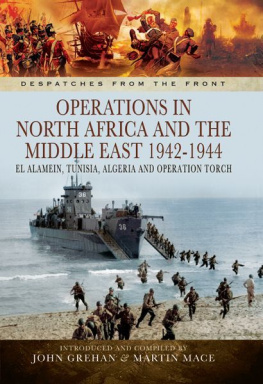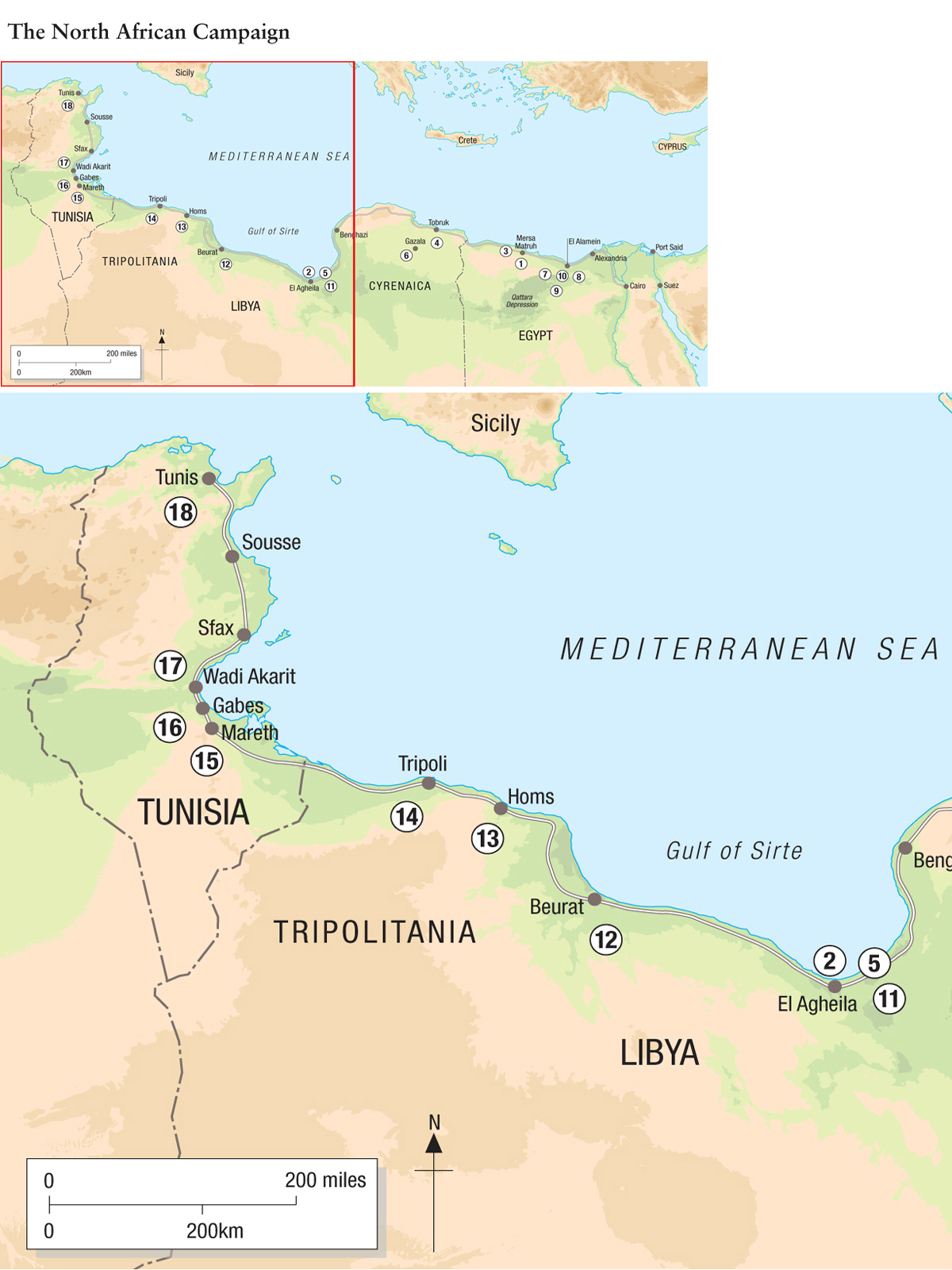CAMPAIGN 250
THE MARETH LINE 1943
The end in Africa
| KEN FORD | ILLUSTRATED BY STEVE NOON
Series editor Marcus Cowper |
CONTENTS
1. September 1940, an Italian army under Maresciallo Graziani crosses the Egyptian/Libyan border, but is confronted by British forces under the command of Gen. Wavell who pushes the Italians back across Cyrenaica to El Agheila.
2. February 1941, Gen. Rommel arrives in North Africa and attacks from El Agheila to force the British into retreat. They withdraw to the Egyptian border leaving Tripoli under siege.
3. May/June 1941, Gen. Wavell launches two attacks, Operations Brevity and Battleaxe, to relieve Tobruk; both fail.
4. November 1941, British forces, now formed into Eighth Army under Lt. Gen. Cunningham launch a major offensive, Operation Crusader. Tobruk is relieved and Rommels forces are pushed right back to El Agheila.
5. January 1942, Rommel goes onto the offensive once more and pushes Eighth Army, now under the command of Lt. Gen. Ritchie, back to prepared positions at Gazala.
6. May 1942, Rommel launches a major offensive that retakes Tobruk and pushes Eighth Army back to El Alamein in Egypt. Gen. Auchinleck replaces Ritchie at the head of Eighth Army.
7. July 1942, Rommel attacks positions at El Alamein but is defeated by Auchinleck.
8. August 1942, Montgomery replaces Auchinleck as commander of Eighth Army who reorganizes the formation ready to go on the offensive.
9. August/September 1942, Rommel tries again to break the line at El Alamein in the battle of Alam Halfa but fails through lack of strength.
10. October/November 1942, Montgomery launches his attack at El Alamein and defeats Rommels army which is forced to retreat right back to El Agheila.
11. December 1942, Montgomerys planned attack on the El Agheila positions meets only enemy rearguards; Rommel has retreated to Buerat.
12. January 1943, Rommel employs delaying tactics at Buerat and then withdraws to a new line at Homs.
13. End of January 1943, Rommel withdraws from Homs when reports reach him that the British are outflanking the line through the desert.
14. January 1943, Tripoli is given up and Rommel withdraws into Tunisia.
15. March 1943, Axis forces under Gen. Messe make their last attack in North Africa when they launch the abortive operation against Medenine.
16. March 1943, Eighth Army breaks through the Mareth Line defences.
17. April 1943, Eighth Army breaks through the defences at Wadi Akarit.
18. May 1943, Tunis falls and all Axis forces in North Africa surrender to the Allies.
ORIGINS OF THE BATTLE
On 4 November 1942, the defeat of Panzerarmee Afrika under the command of Generalfeldmarschall (GFM) Erwin Rommel by Lieutenant-General (Lt. Gen.) Bernard Montgomerys Eighth Army in the battle of El Alamein proved to be the climax of the Desert War. The struggle that had begun in September 1940 against Italian forces on the LibyanEgyptian border had by then reached its critical moment a trial of strength in which a dramatic breakthrough would have been possible by whoever proved to be the most determined. It was Montgomery who succeeded.
The conflict in North Africa had progressed from a fight between two colonial powers into a theatre of war which captured the attention of the whole world. After Britains repulse in the Battle of France in June 1940 and its exit from the continent of Europe through Dunkirk, the North African desert was the only place in which its land forces opposed the enemy.
The theatre was the scene of many large-scale battles, especially after Italian troops were joined by those from their ally Germany under the command of Erwin Rommel. Actions were fought over wide-open tracts of desert in a harsh environment that punished the unwary. As one side moved away from its supply bases, the other side grew closer to its own. Growing strength on one side was met with gradual weakening on the other. Progress was a to-and-fro trek between the deserts of Libya and Egypt as each side in turn gained the upper hand.
A soldier examines an Italian M13/14 tank that had been knocked out at Alamein. (DA-02734, War History Collection, Alexander Turnbull Library, Wellington NZ)
Italian prisoners in captivity after the battle. Most had been left behind without transport as the Germans rushed away from the battlefield in their tanks and trucks. (IWM, E21541)
A New Zealand padre conducts a burial service for some of the fallen at El Alamein. (DA-11753, War History Collection, Alexander Turnbull Library, Wellington NZ)
Over a period of more than two years, many leading commanders had seen their reputations won or lost in the desert through the battles they had fought. The disaster of the loss of Tenth Army by the Italian commander Graziani was in great contrast to the success gained by Lieutenant-General Richard OConnor, whose outflanking movements across vast wastes were later employed by Rommel. This initial success was soon followed by General Archibald Wavells efforts throughout 1941. With few resources and the need to supply troops to diversions in Greece and Crete, Wavells command brought little reward. Auchinleck, who followed him, could count the successes of Operation Crusader and First Alamein amongst his battle honours, but he, like Wavell, fell victim to Prime Minister Winston Churchills impatience for greater victories.
The Desert War was dominated by the charismatic German commander Erwin Rommel. After his arrival in Libya on 12 February 1941, the situation changed completely. Rommel brought with him the units that were to become the famed Deutsches Afrika Korps (DAK). His expertise, daring exploits and bold leadership created a type of warfare that had the British reacting to his moves. There is little doubt that his superiority in generalship, and the greater effectiveness of his tanks and weapons, always placed his opponents at a disadvantage. His greatest problem was one of supply and it was this shortcoming that compromised his plan to capture Egypt and cross the Suez Canal into the Middle East. Whether this might actually have been a possibility remains a subject for historians to debate, but there is little doubt that if his Panzerarmee Afrika had had sufficient strength to go on the offensive at Alamein, the outcome of the Desert War might have been quite different.
Lieutenant-General Bernard Montgomery had arrived in Egypt at a most opportune moment. General Claude Auchinleck before him had by then halted Rommels advance into Egypt and had won the first battle of El Alamein. When Montgomery took over Eighth Army in August 1942, he had only part of Auchinlecks old command to deal with. Auchinleck before him was Commander-in-Chief Middle East and had responsibility for the war in North Africa and for the troubles in Iraq, Persia, Palestine, etc. Montgomery was given just Eighth Army and reported to General Sir Harold Alexander who held responsibility for the remainder of the Middle East. Montgomery also had the luxury of not attacking until Eighth Army had been massively reinforced, retrained and had plentiful supplies. This superiority in numbers of troops, weapons and new skills after so many years of having to make do with what was available, was the means with which he was able to overwhelm Rommel on the battlefield.

























